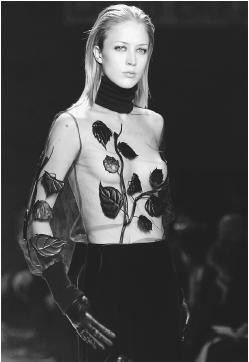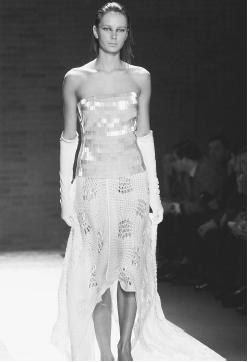Laura Biagiotti - Fashion Designer Encyclopedia
Italian designer
Born: Rome, Italy, 4 August 1943. Education: Degree in archaeology, Rome University. Family: Married Gianni Cigna, 1992; children: Lavinia. Career: Worked in Biagiotti family ready-to-wear firm, Rome, 1962-65; freelance designer for Schuberth, Barocco, Cappucci, Heinz Riva, Licitro, and others, 1965-72; founder/designer, Laura Biagiotti Fashions, Rome, from 1972; took over MacPherson Knitwear, Pisa, 1974; established headquarters in Guidonia, 1980; introduced Rispeste collection, 1981; introduced Laurapiu collection, 1984; launched diffusion knitwear collection for Biagiotti Uomo, 1985; Biagiotti jeans collection debuted, 1986; Biagiotti Uomo collection, 1987; created perfumes Laura, 1982, Night, 1986, Roma, 1988, and Venezia, 1992; signed licensing agreement for Biagiotti shops in China, 1993; opened LB shop in Beijing, Bangkok, and Moscow,

Publications
On BIAGIOTTI:
Books
Mulassano, Adriana, The Who's Who of Italian Fashion, Florence,1979.
Alfonsi, Maria-Vittoria, Leaders in Fashion: I Grandi Personaggi Della Moda, Bologna, 1983.
"Laura Biagiotti," in Bonizza Giordani Aragno, ed., Moda Italia (Milan), 1988.
Skellenger, Gillion, "Laura Biagiotti," in Contemporary Designers, London, 1990.
Steele, Valerie, Women of Fashion, New York, 1991.
Stegemeyer, Anne, Who's Who in Fashion, Third Edition, New York,1996.
Articles
Gargia, Massimo, "Laura Biagiotti, Stylish et Italienne," in Vogue (Paris), August 1978.
Petroff, Daniela, "Women Designers," in the International Herald Tribune, 3 October 1981.
"Laura Biagiotti: Bianco per Tutte le Mode," in Vogue (Milan),October 1984.
"The House of Biagiotti," in House & Garden, December 1986.
"I Cashmere Ricamati di Laura Biagiotti," in Donna (Milan), October 1987.
"Laura Biagiotti: I Piaceri Naturali," in Donna (Milan), February 1988.
Menkes, Suzy, "Couture's Grand Ladies," in Illustrated London News, Spring 1990.
Lender, Heidi, "Biagiotti's U.S. Invasion," in Women's Wear Daily, 12 February 1992.
Costin, Glynis, "Laura Biagiotti's China Syndrome," in Women's Wear Daily, 21 May 1993.
Cover story on Biagiotti, in Fashion Magazine, September 1994.
Schiro, Anne-Marie, "Fashion: Russia, Women at Work and Elegance," in the New York Times, 8 March 1995.
Barone, Amy B., "Fragrance Launch Fever," in Drug & Cosmetic Industry (New York), March 1997.
Ball, Deborah, "In Fashion, Grasping English is as Relevant as Last Year's Handbag," in the Wall Street Journal, 17 October 2000.
Davis, Don, "New Lines," in Global Cosmetic Industry (New York),May 2001.
***
Indisputably Italian, trained by her tailor mother to admire the couture of France but also witness to the quality of her mother's work and employed early on in Schuberth's elegant Italian ready-to-wear, Laura Biagiotti might seem the quintessential European. She is firmly devoted to fine materials, especially Italian, and has been called the

Looking at Biagiotti's clothes, however, one cannot help but think of America. Like Giorgio Armani, Biagiotti bespeaks Italian fashion but was redefining Italian fashion in the last quarter of the 20th century in a sense of sportswear, separates, menswear influences, and quality materials for the standardizing templates of clothing. Biagiotti tells the story that at the time of her first show in 1972, she had so few pieces that she showed one white jacket three times, once with a skirt for morning, once with a day dress, and finally with a shiny skirt for evening. "Unintentionally I had invented the use of only one item for morning to evening," she said.
If Biagiotti was, as she professes, initially inadvertent, her concept has become canny and global; her invention is necessarily as smart as it is coy. Her collections in the 1980s and 1990s sustained a sense of the marketably traditional, always freshened with insights and style inflections to become one of the most effective designers of the era.
Biagiotti's spring-summer 1990 collection, built around navy, red, and white (admittedly with other pieces as well but carefully constructed around the red, white, and blue core), not only anticipated 1993 merchandising of Carolyne Roehm but offered its clothes as wardrobe builders as well as dramatic outfits. Talking about her work to Valerie Steele for Women of Fashion: Twentieth-Century Designers (New York, 1991), Biagiotti said, "Elegance, taste, and creativity have belonged to the Italian tradition and character for centuries and I share this privilege with all other Italian designers."
Biagiotti has studied archaeology and is much engaged with the arts and architecture through generous support of archaeology and conservation. Yet again, her work is as much divorced from the historical past as one could imagine. It is as if she chose to restore the edifice (and she does live and work in what Gillian Skellenger, in Contemporary Designers, rightly calls the factory-castle of Marco Simone near Rome, a Romanesque-era edifice), but her decision is a gutted rehabilitation, putting everything new inside. There are no marks of historicism in her clothing, even in the fall-winter 1985-86 collection, when her monastics seem as much about Claire McCardell as about medievalism. Her abiding preference for white is symbolic, clean and notably modern in style, while her sensible knits address manifold uses for contemporary working women. As Skellenger noted, "Biagiotti reveals a mania for research," committed to new fabric study.
Biagiotti has spoken of her work as a personal projection, fit for a modern, self-confident, and business-aware woman. If she is considered the ideal client for her own clothing, her personal sensibility is toward simple almost reductive shape carried in luxury materials, an ethos sounding like three generations of American sportswear-to-evening designers. The women's clothing can be slightly flirtatious in the American mode, whereas her evening looks express her Roman sophistication, always with a reserve and sense of good taste. Biagiotti has come to represent decorum and fashion nuance unerring in its mainstream elegance, again a characterization she would share with Armani. What she does not share with Armani is his intense interest in menswear per se—while Biagiotti has designed menswear for many years, it seems even safer than her women's clothing and the epitome of conservative good taste.
Following the opening a Biagiotti boutique in Moscow, the Italian designer was invited to do a fashion show in the Kremlin. Featuring opera, ballet, and Biagiotti's fall collection, the 1995 show, not surprisingly, incorporated a taste of Russian elegance. Almost every piece of clothing—from evening dresses to pocket flaps—consisted of cashmere, thus reconfirming the designer's acclaimed title, Queen of Cashmere. In addition to cashmere, Biagiotti reintroduced beaded-flower, embroidered dresses in her Milan fashion show.
As 1997 neared and perfume launch activity began to slow, Italian perfumers released high-profile fragrances, including Biagiotti's Sotto Voce. Alone, the perfume did not, nor was it expected to, drive holiday sales. Even with the help of classics such as Tresor, Chanel No. 5, and Eau Sauvage, perfumes did not win over consumers' attention as they had in the past. With a new fragrance line, Laura Biagiotti Roma, launched in fall 2001, Biagiotti hoped to attract customers the perfume industry had not seen in years. As the fragrance is geared toward the younger generation, it was less expensive and more accommodating to a youthful market's budget. Laura Biagiotti Roma was available for both men and women, and had a seven-year licensing agreement with Singer International.
—RichardMartin;
updated by DianaIdzelis
Comment about this article, ask questions, or add new information about this topic: